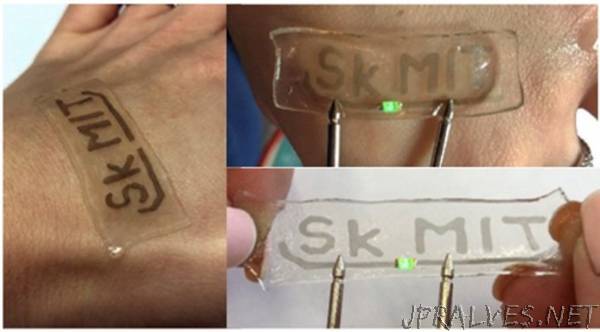
“Scientists from the Skolkovo Institute of Science and Technology (Skoltech) and the Massachusetts Institute of Technology (MIT) have proposed a novel method for the fabrication of highly transparent, electrically conductive, stretchable tough hydrogels modified by single-walled carbon nanotubes (SWCNTs). The results of the study have been published in ACS Applied Materials & Interfaces.
SWCNT/hydrogel-based patterned circuit pictured in three ways: attached to human skin, relaxed, and stretched by 50 percent.
Hydrogels are novel soft materials that have made possible or improved upon an array of modern technologies, such as tissue engineering, drug delivery, biomedical devices, stretchable/bio-integrated electronics and soft robotics. Furthermore, hydrogels that have similar physiological and mechanical properties as human skin are ideal materials for effective bio-integration of such electronics devices. Electrically conductive hydrogels (ECHs) are attracting much interest in the field of biomaterial science due to their unique properties. However, the effective incorporation of conductive materials in the matrices of hydrogels for improved conductivity remains a great challenge.
SWCNTs are a unique family of materials exhibiting exceptional thermal, electronic and mechanical properties, and therefore have been utilized as nanofillers of nanocomposite hydrogels.
In this research, the scientists used a one-step technique to facilitate the dry transfer of SWCNTs on hydrogels, thereby making it possible to avoid problems associated with SWCNT agglomeration, and the removal of surfactants, while also simplifying the whole fabrication process.
The researchers demonstrated two ways of fabricating SWCNT/hydrogel structures. The first approach is based on a simple transfer of the SWCNTs from a filter to the as-prepared hydrogel surface, while the second one is based on the pre-stretching of the hydrogel before the SWCNT film is deposited. Based on the performed characterization, the first approach can be used for SWCNT/hydrogel structures utilization as strain-sensitive material; the team observed stable behavior during 5,000 stretching/releasing cycles.
The second approach of such structure fabrication makes it possible to overcome low conductivity at high strains and ensure high transparency. Moreover, it can be utilized for applications, where the stable performance of the electrodes during stretching is needed without the alteration of the electrical properties.
“In this work, we report new transparent, stretchable, conductive and biocompatible hydrogels modified by SWCNT films to create passive electrodes and active sensors for wearable and skin-like electronics. We introduce here a one-step, universal and applicable method for SWCNT/hydrogel structure fabrication, able to withstand intrinsic stretching of up to 100% strain. Our method of SWCNT film patterning makes it possible to create large-area electronic circuits, as well as a variety of wearable devices, including electronic skins,” said Skoltech PhD student Evgenia Gilshteyn, the first author of the paper.
“Using the proposed approach, we created mechanically robust, highly stretchable, biocompatible, conductive and transparent SWCNT/hydrogel structures and demonstrate their applications as finger-mounted joint motion sensors and electrocardiographic electrodes. The advantages of the proposed structures in terms of conductivity, stretchability, transparency and applicability for electronic circuit creation are evident and discussed in our research paper,” said Skoltech Professor Albert Nasibulin, who noted that the project received support from the Skoltech-MIT Next Generation Program and the Russian Science Foundation.”
